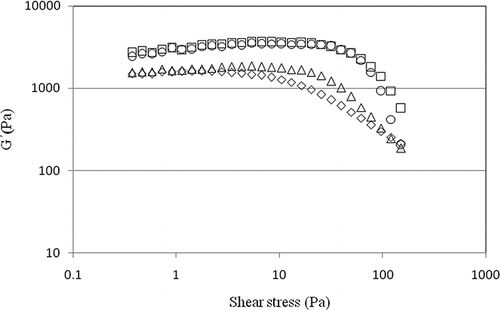Abstract
The small and large deformation properties of different low-calorie pistachio butter formulas were studied in order to develop a background understanding of the changes in viscoelastic and textural characteristics that occur due to different types of fat replacers and sweeteners. Frequency, temperature, and time sweep analysis and also back extrusion and texture profile analysis tests were performed. The magnitudes of dynamic moduli increased in the frequency sweep test with loss tan values <1. The elastic structure of all samples changed to viscous behavior with increasing temperature (5–65°C), regardless of the type of fat replacers and sweeteners’ level. The temperature sweep test on heating and cooling samples resulted in higher viscoelastic properties and more solid-like behavior. There was no time dependency for loss tan at 45°C. A modified Cox-Merz rule could superimpose the steady and complex viscosity data. There was a good agreement between the results of G′ and hardness in small and large deformation tests.
INTRODUCTION
Stressing the importance of diet in the prevention of certain diseases, nutrition scientists have emphasized on the reduction of fat in consumers’ diet. To respond to this consumers’ demand, the food industry has offered reduced-fat versions of standard products. In addition to nutrition, fat affects the physical, chemical, and sensory characteristics of food products. Therefore, it is difficult to reduce the fat and calorie content of a food product while maintaining all characteristics of the primary full fat formula.
Pistachio butter is a pasty formed nutritive product that contains pistachio, sweetener, and flavor improver.Citation[1] The low-calorie version of its standard full fat form has recently been formulated.Citation[2] From a physical view, the low-calorie pistachio butter is an O/W emulsion, and stabilization of the formula is dependent on the viscosity of the continuous phase. According to the significant texturizing effect that food hydrocolloids can bring to the food products, it is not surprising that they can generally be expected as appropriate fat-replacers.[3] Xanthan is a versatile hydrocolloid that can be used in low-fat products due to its ordered molecular structure.Citation[3] Lallemantia royleana (with vernacular name Balangu) and Ocimum basilicum (with vernacular name Reihan) are mucilaginous endemic plants that grow in different parts of Iran. Recent rheological studies have proved that their mucilaginous extract can be used as a novel food hydrocolloid in food formulations.Citation[4, Citation5]
The other food ingredients that could be considered in the structure and behavior of low-calorie foods are sweetener alternatives. Isomalt is a sugar replacer that can contribute in the development of products with specific characteristics. The products are glycaemic, low insulinaemic, reduced in calories, and do not promote teeth cavity.Citation[6]
One of the most important aspects in developing novel food products is having knowledge about their rheological properties. Rheological properties of food emulsions play an important role in understanding the structural organization of food,Citation[7] developing food products,Citation[8] processing, transportation,Citation[9] stability, and mouth feel of the products.Citation[10] Pressini et al.[11] emphasized that dynamic tests at low oscillation amplitudes can give a good understanding of the link between the structure and the macroscopic measurable properties. For fluid foods containing suspended particles, oscillatory rheometry, by applying a very small oscillatory stress, can properly characterize the viscoelastic behavior of foods and relate dynamic parameters to a sample's molecular structure.[7] There is only one published study on the rheological behavior of full fat pistachio butter,[1] in spite of many studies dealing with the rheological characteristics of peanut butterCitation[12– Citation14] and sesame paste.Citation[15, Citation16]
To obtain more knowledge on the rheological behavior of low-calorie pistachio butter as a novel food product, a series of experiments were conducted.Citation[17, Citation18] Following the previous experiments and according to the importance of small amplitude oscillatory shear (SAOS), the objectives of this study were to (i) investigate the dynamic rheological behavior as a function of frequency, time, and temperature; (ii) evaluate the applicability of the Cox-Merz rule between the steady shear viscosity and complex viscosity values; (iii) study the textural properties using texture profile analysis (TPA) and back extrusion as large deformation tests; and (iv) compare the results obtained in SAOS and large deformation experiments for low-calorie pistachio butter as affected by fat replacers and sweeteners.
MATERIALS AND METHODS
Materials
In a preliminary study, the effects of three hydrocolloids as fat replacers (Reihan seed gum [RSG], Balangu seed gum [BSG], and xanthan gum [XG]) and two sweeteners (sucrose and isomalt) were investigated. On the basis of the conditions constructed using central composite design (CCD), 20 experiments were carried out for each fat replacer. They were all evaluated by sensory and steady shear rheological measurements and then optimized using Minitab statistical software (version 13.2, MINITABTM, PA, USA). The results of the optimization process are presented in .
Table 1 Optimized levels (g) for preparation of 400 g low-calorie pistachio butter samples
In the present study, complementary measurements were conducted on the three optimized formulations. The O'hadi variety of pistachio was obtained from Kashmar city, Khorasan province in Iran, for preparing formulations. An oil reduction of ≥25% was achieved by pressing the pistachio kernels in an oil extraction unit. Isomalt was procured from Sim-Sim Company, Mashhad, Iran. Sucrose and vanilla were obtained from local markets. Potassium sorbate and lecithin were purchased from Merck (Darmstadt, Germany) and Acrose (Geel, Belgium) companies, respectively. The proper amount of hydrocolloid, potassium sorbate (0.08%), and lecithin (1.5%) was dissolved in distilled water using a stirrer and then added to the pre-blended mixture of pistachio paste, sweetener, and vanilla. All the ingredients were then mixed with the pre-defined amount of distilled water and the final product was homogenized using an ultra turrax T25 at 9500 rpm for 10 min (IKA Labortechnik, Staufen, Germany).
Small Deformation Rheological Analysis
Dynamic measurements were performed using a controlled stress Bohlin CVO rheometer (Bohlin Instruments, Inc., Worcestershire, UK) equipped with a 15-mm parallel plate measuring system and 1.5 mm gap. Specimens were loaded in the geometry using a spatula and the plate was slowly raised to the specified measuring position. The excess specimen was completely trimmed off using the spatula. For each measurement a new sample was used. The exposed specimen was coated with silicone oil to prevent the samples from dehydration. Oscillatory measurements were performed at least in duplicate.
Stress sweep
In order to ensure that all measurements were conducted in the linear viscoelastic region (LVR), an amplitude stress sweep test was done at a frequency of 1 Hz and with a shear stress range from 0.024–150 Pa for all samples and at different temperatures (5, 25, 45, and 65°C). The limit of the linear viscoelastic region was achieved by the point beyond which storage modulus revealed a 5% deviation from its maximum value.Citation[19] A shear stress of 10 Pa, within the linear region, was applied for dynamic tests.
Frequency sweep
The samples were subjected to oscillatory measurements at a frequency range of 0.1–100 Hz, shear stress of 10 Pa, and temperatures of 5, 25, 45, and 65°C. The storage modulus (G′), loss modulus (G″), loss tangent (tan δ), and complex modulus (G*) were determined to evaluate the viscoelastic behavior of samples.
Temperature sweep
The changes in viscoelastic properties of samples during heating from 25 to 70°C and subsequent cooling to 25°C were measured using a temperature table test. The temperature sweep test was performed at 15°C intervals, shear stress of 10 Pa, and at a frequency of 1 Hz.
Time sweep
Time sweep tests over the LVR were recorded at 1 Hz frequency and 10 Pa shear stress. Tests were performed at 25, 45, and 65°C. The measurements were repeated at least twice.
Texture Evaluations
The texture analysis measurements were conducted using a TAXT2 texture analyzer (Stable Micro Systems, Godalming, UK). The load cell was calibrated with a 5 kg weight and the equipment was set to zero automatically by lowering the plate until the bottom of the plate contacted the surface. Two empirical methods, including TPA and back extrusion, were used for texture evaluation of low-calorie pistachio butters. The TPA analysis was performed using a P/25L probe (Stable Micro Systems, Godalming, UK). Measurement was performed 24 h after production. Test conditions were: uniaxial 2-cycle compression with a 25-mm-diameter cylindrical flat probe; penetration to a depth of 4 mm; and crosshead speed of 0.1 mm/s. From the resulting force-time curve, hardness (the maximum force measured during the first compression cycle), adhesiveness (the negative force area of the first cycle), gumminess (the result of hardness × cohesiveness), and cohesiveness (the ratio of the positive force area during the second cycle to that during the first cycle) were determined. For back extrusion measurement, the sample was poured into an acrylic container (50 mm internal diameter) to a depth of 20 mm. A 40-mm disk (A/BE) and a crosshead speed of 1 mm/s with a test distance of 15 mm were the other adjustments. Firmness (the maximum force), consistency (the positive area), and adhesiveness (the negative area) were determined.
Statistical Analysis
The statistical analysis of the experimental data was performed using MSTATC statistical software (Version 1.42, MI, USA). The results were subjected to analysis of variance and the means were compared using the least significant differences (LSD) test. Drawing the graphs and fitting models were performed by Microsoft Office Excel 2007 (USA).
RESULTS AND DISCUSSION
Dynamic Viscoelastic Oscillatory Measurements
Stress sweep
shows the stress sweep results for a representative formula prepared using XG (as a fat replacer) at different temperatures. Within the linear region, both elastic and viscous moduli are stress-independent. The decreasing deviation from linearity in all samples and at all temperatures can be corresponded by breaking bonds. It can be seen that the width of the linear viscoelastic region depends on temperature. Other researchers have also mentioned this dependency before.Citation[20, Citation21] The deviation from linearity and the disruption of structure was sharper in higher temperatures. Similar results were obtained for the other two samples (figures not shown). To ensure the test was conducted in LVR, 10 Pa shear stress was selected for all samples at all temperatures.
Frequency sweep
Frequency sweep experiments of low-calorie pistachio butters were carried out at 5, 25, 45, and 65°C. It was found that the magnitude of both G′ and G″ increased with frequency. For all experiments, G′ was always higher than G″ over the whole frequency range with the moduli almost parallel to each other. This behavior resembles that of a viscoelastic solid, i.e., deformation in the linear region will be essentially recoverable. It is an indication of strong interaction and/or a stabilized form of network structure.[9] The increasing trend of viscoelastic moduli with frequency was previously reported for other food spreadable products.Citation[8, Citation22– Citation25] No G′–G″ cross-over and higher values of G′ than G″ has been referred to as a gel.Citation[26] The frequency sweep curves related to the formulas containing RSG, BSG, and XG are shown in , , and , respectively. G′ curves of all samples revealed a sharp increase at frequencies higher than 20 Hz and it seems to be the effect of a very fast deformation process. The greater solid-like structure at higher frequencies can be explained by Deborah number (De), which states that all materials tend to exhibit higher solid-like characteristics over a shorter experimental time scale (high frequency).Citation[27] For any fluid, De is defined as:
Figure 3 Frequency sweep for low-calorie pistachio butter containing BSG (◊: 5°C; Δ: 25°C; □: 45°C; ◯: 65°C).
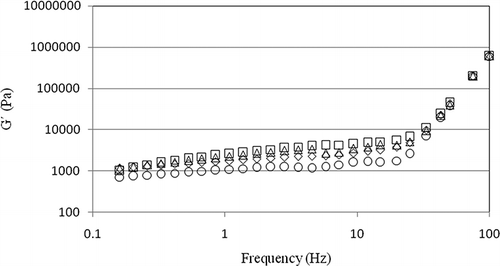
Figure 2 Frequency sweep for low-calorie pistachio butter containing RSG (◊: 5°C; Δ: 25°C; □: 45°C; ◯: 65°C).
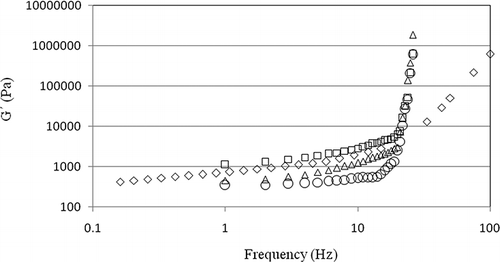
Figure 4 Frequency sweep for low-calorie pistachio butter containing XG (◊: 5°C; Δ: 25°C; □: 45°C; ◯: 65°C).
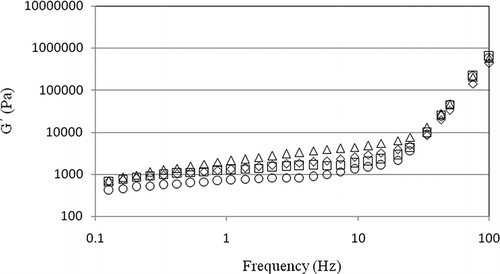
where λ rel is the characteristic relaxation time of the material and θ is the characteristic time of the deformation process. The number represents the ratio of duration of fluid memory to the duration of the deformation process. Ciftci et al.[9] studied the rheological characteristics of sesame paste and showed that the magnitudes of both dynamic moduli increase with frequency. They also reported a sudden increased phenomenon around 10 Hz frequencies. On the other hand, the magnitude of both moduli increased with increasing temperatures (). A polynomial regression was fitted on dynamic moduli-frequency data and it was found that both G′ and G″ were dependent on frequency (0.957 < R 2 < 0.999). A slight dependency over frequencies lower than 20 Hz and a strong dependency over the magnitudes higher than 20 Hz were observed (Figs. ). The changes in G′ with frequency are ignorable at frequencies lower than 20 Hz. As the temperature was increased, the loss modulus started to increase harshly and became closer to storage modulus, i.e., the sample started exhibiting liquid-like behavior. It seems that melting of the fat and increasing the protein mobilization have led to this observation. The loss modulus seems to be overlapped by the storage modulus and the viscous and elastic behaviors are in an equal condition at 65°C. Similar trends were observed for the other two formulas with higher G′ values for samples prepared using BSG.
The loss tangent presents a good indication of whether elastic or viscous properties predominate.Citation[24] For all three samples, tan δ increased with frequency, which indicates a higher contribution of the viscous component at higher frequencies. It, however, showed a decrease by passing the 20 Hz frequency. represents the tan δ changes with frequency for samples containing XG. Similar results were obtained for the other two samples. A loss tan of 0.436–0.961 for RSG, 0.392–1.221 for BSG, and 0.401–0.959 for XG were found to vary between 5 and 65°C, which is an indication of viscoelastic nature in most cases. It is also worth mentioning that loss tan increased with temperature representing a more viscous behavior.
Figure 5 Loss tan as a function of frequency for low-calorie pistachio butter containing XG (◊: 5°C; Δ: 25°C; □: 45°C; ◯: 65°C).
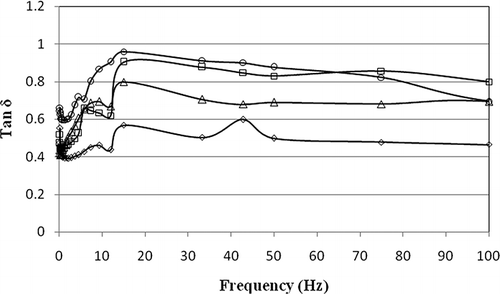
Studying the dynamic behavior of date paste, Ahmed and Ramaswamy[8] reported that increasing the temperature had a decreasing effect on dynamic moduli, while at selected temperatures; the storage modulus was much higher than loss modulus. They also showed that G″ was more dependent on the frequency compared to G′.
Table 2 The means and standard deviation of elastic modulus (G′), viscous modulus (G′′), loss tan (Tan δ), and complex modulus (G*) of the low-calorie pistachio butter at 1 Hz frequency
For comparing the results of G′, G″, tan δ, and G* at different temperatures, the reference oscillation frequency of 1 Hz was chosen. The obtained values are shown in . Generally, it is expected that emulsions with a greater fat content show higher values of G′.Citation[28] However, this effect was counterbalanced by addition of the fat replacers. The obvious difference between the storage modulus for formulas containing RSG and the other two formulas would be probably due to the incomplete hydration of RSG during 24 h of storage. Increasing the temperature to 45°C resulted in an increase in G′, G″, and G*, while increasing to 65°C caused a decrease. Globulins and specifically Vicilins are the main protein components in pistachio.Citation[29] It seems that the unfolding process of proteins is responsible for this observation. The values of loss tan can also confirm the disruption of some protein networks and its subsequent decreasing effect on elastic modulus.
Temperature sweep
The data of G′, G″, tan δ, and μ* for all three formulas at selected temperatures are presented in . Heating the samples from 25 to 70°C resulted in an increase in elastic modulus, while it has made the viscous modulus to be decreased between 25–40°C and then increased. For all samples, the elastic modulus was higher than the viscous modulus, an indication of gel behavior. The loss factor values also confirm that the elastic component has predominated the viscous component (an exception for the highest temperature of the sample containing RSG).
Table 3 The means and standard deviation of elastic modulus (G′), viscous modulus (G′′), and loss tan (tan δ) of the low-calorie pistachio butter at different temperatures
The results showed that by increasing the temperature to 70°, the samples changed from a semi-solid material to a viscous fluid and this behavior was revocable for the formulas containing RSG and in a more considerable manner for XG. Although there was a remarkable temperature hysteresis for all samples, there was no significant difference between loss tan values in the cooling stage and heating one for samples containing RSG (P < 0.05). The cooling process has made a stronger gel for formulas prepared using xanthan gum (). During the cooling stage, the unfolded proteins approach each other while the water and fat molecules are trapped into the matrix. Therefore, the role of protein in the final texture will be more important than water and fat, resulting in higher viscoelastic properties and more solid-like behavior[24] (). It seems that the observed discrepancy for samples prepared using BSG is due to its isomalt content and, therefore, the free water that is the highest value among the studied formulas ().
Time sweep
Figures 6–8 present the changes in tan δ of samples containing selected hydrocolloids as a function of time. The larger the loss factor value, the more the sample flow. For all samples, the tan δ values showed a predominant solid behavior at the range of time studied. It is obvious that at higher temperatures the samples show less solid behavior, which is an expected phenomenon. In general, viscoelastic systems tend to be more elastic at lower temperatures.Citation[30] There was no change in the loss tan values at 65 and 45°C with time, i.e., time at the studied range has not affected the ratio between viscous and elastic components.
Figure 6 Loss tan as a function of time for low-calorie pistachio butter containing RSG (Δ: 25°C; □: 45°C; ◯: 65°C).
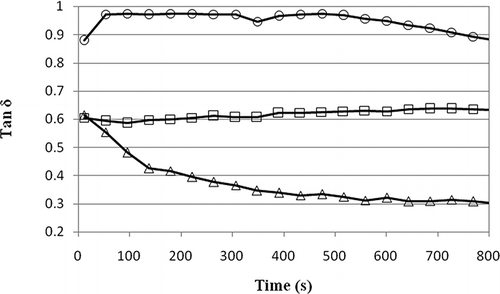
Figure 7 Loss tan as a function of time for low-calorie pistachio butter containing BSG (Δ: 25°C; □: 45°C; ◯: 65°C).
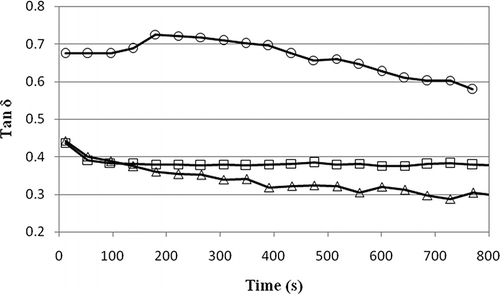
Figure 8 Loss tan as a function of time for low-calorie pistachio butter containing XG (Δ: 25°C; □: 45°C; ◯: 65°C).
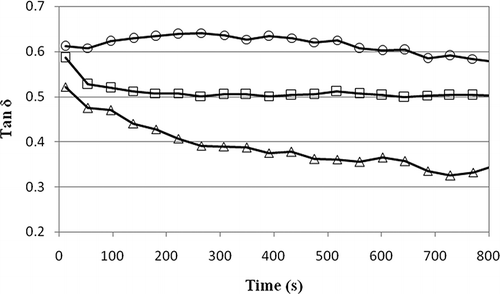
To evaluate the stability of formulas at various temperatures, the data of complex modulus against time were studied. shows the changes in complex modulus with time for a formula containing BSG. It can be seen that the complex modulus decreased with temperature. A similar result was reported by Muliawan and HatzikiriakosCitation[21] for mozzarella cheese. The value of complex modulus was approximately constant upon the range of time studied at 45 and 65°C, but at room temperature it showed an increasing trend. It seems that gel formation has occurred at this temperature. Similar results were obtained for formulas containing RSG and XG (figures not shown).
Applicability of Cox-Merz Rule
There is an empirical relationship between complex viscosity and steady shear viscosity known as the Cox-Merz rule. The empirical Cox-Merz rule states that the complex viscosity and the steady shear viscosity values should be superimposed at equal values of frequency and shear rates:
where η* and η are complex viscosity and shear viscosity, respectively. It was originally proposed for synthetic polymers, but its original and modified forms have been applied for many food products.Citation[7, Citation31]
In this article, the Cox-Merz rule was evaluated in the studied shear rate (0.1–50 s−1) and frequency (0.1–50 Hz) range. shows a typical relationship between the data obtained for complex viscosity and steady shear viscosity in the sample prepared using RSG. The samples prepared using XG and BSG also showed similar trends. The results showed that for all formulas and at all studied temperatures the η* values were higher than η and there was a gap between the two data series. However, parallel dependencies of η* on frequency and η on shear rate were observed. Complex viscosity is measured within the linear viscoelastic region and, therefore, no structural disruption happens. But steady shear measurements cause structural damage and, subsequently, lower viscosity magnitudes.Citation[32]
Figure 10 The comparison of the complex and steady shear viscosity for low-calorie pistachio butter containing RSG; opened and filled symbols indicate the results of steady shear and dynamic measurements, respectively (□: 5°C; Δ: 25°C; ◯: 45°C; ◊: 65°C).
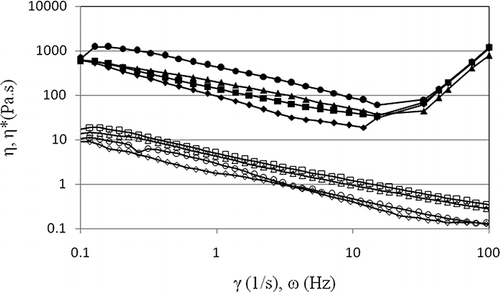
Introduction of a shift factor (k) could superimpose the complex viscosity on steady shear viscosity (EquationEq. 2):
The values of shift factor and the coefficients of determination for superimposing steady shear viscosity and modified complex viscosity are presented in . The R 2 values show that the modified Cox-Merz rule was applicable for low-calorie pistachio butter. There were no systematic changes in the shift factor with temperature and the highest k factor was observed at 65°C for all three formulas. It seems that melting of fat and unfolding of proteins at temperatures higher than 45°C resulted in an increase in fluidity. Ahmed and Ramasway[7] studied the relation between steady and dynamic viscosities of sweet potato puree infant food by modified Cox-Merz rule and reported that there was no systematic variation in constant k with temperature. Juszczak et al.[31] showed that the modified Cox-Merz rule (one-parameter) is not capable of fitting the steady and dynamic viscosity data of selected commercial mustards. They used the generalized two-parameter) form of Cox-Merz rule[32] as follows:
Table 4 Shift factor (constant k) values and coefficients of determination of low-calorie pistachio butter samples at different temperatures obtained for superimposing steady shear viscosity and complex viscosity
Table 5 Textural attributes of low-calorie pistachio butter formulas
Textural Measurements
The textural attributes of formulated low-calorie pistachio butter was investigated through large deformation techniques and presented in . According to the results of TPA, the lowest hardness, cohesiveness, and, subsequently, gumminess values were obtained for the formula containing RSG (). The result of hardness measurement was also observed in the SAOS test, where the elastic modulus of samples containing RSG was lower than that of the other formulas (). Abegaz and Kerr[32] stated that for viscoelastic materials, an increase in firmness may occur from a greater elastic or viscous component. A relationship between the storage modulus and the hardness property in a W/O system was recently reported by Alexa et al.Citation[34] It is also worth noting that the highest and lowest magnitudes of hardness in both methods were obtained for samples containing BSG and RSG, respectively. Adhesiveness is the work necessary to pull the probe away from the sample, and formulas prepared using BSG and RSG showed the highest and lowest magnitudes of adhesiveness (). Isomalt does not absorb a noticeable amount of moisture[6] and, therefore, having the highest and lowest adhesiveness values for the formulas containing the most and the least isomalt content could be predictable. Muego et al. evaluated the textural attributes of two different samples (peanut butter and peanut paste) using penetration, compression, and TPA tests. Their results showed that the applied instrumental methods can differentiate between the textural characteristics of the studied samples.[12] Mazaheri-Tehrani et al.[14] studied the textural properties of peanut butter fortified by soy flour. They reported that adhesiveness and cohesiveness can be affected either positively or negatively by replacement of peanut spread by soy flour, respectively.
The results of the back extrusion test confirmed that the highest consistency value was for samples prepared using xanthan gum. It is an indication of the formation of an extensively associated network as compared with the other formulas. The associated network could probably maintain the product structure during storage.Citation[35] The highest value of adhesiveness was obtained for the samples prepared using XG as well. According to the point that the adhesiveness magnitude in the back extrusion test is measured from the work necessary to move up the probe and the amount of sample loaded on the probe during the backward movement, the more fluidity for the sample, the highest the measured adhesiveness value. It seems that the high amount of isomalt and the little amount of pistachio paste have resulted in more fluidity of samples containing XG. Similar trends were observed for the adhesiveness values of TPA and back extrusion tests ().
CONCLUSION
The small and large deformation properties of low-calorie pistachio butter formulas with different fat replacers and sweeteners’ level were evaluated. All formulas showed viscoelastic behavior while G′ was higher than G″ at all frequencies and temperatures (5–65°C). The lower value of the dynamic moduli for samples containing RSG could be an indication of incomplete water adsorption. Regardless of the type of fat replacers and sweeteners’ level, the dynamic rheological data for loss tan did not show a time dependency at 45°C, while an increase in the elastic component was observed at room temperature during storage. The temperature sweep showed that the heating and cooling cycle resulted in a stronger gel formation (exception for formulas containing BSG). Introduction of a shift factor to the Cox-Merz rule made the rule to be well fitted by the steady shear viscosity and complex viscosity. A higher amount of isomalt resulted in higher magnitudes of adhesiveness for samples containing BSG as a fat replacer. Both TPA and back extrusion showed this formula as the hardest sample. There was a good agreement between the results obtained for elastic modulus and hardness in small and large deformation tests.
ACKNOWLEDGMENTS
The experimental facilities of this work provided by the Food Rheology and Structure Laboratory of Boku University are greatly acknowledged. The authors are also grateful to Miss Rezvani for her kind assistance during the experimental phase.
REFERENCES
- Taghizadeh , M. and Razavi , S.M.A. 2009 . Modeling time-independent rheological behavior of pistachio butter . International Journal of Food Properties , 12 ( 2 ) : 331 – 340 .
- Emadzadeh , B. , Razavi , S.M.A. , Nassiri Mahallati , M. and Farhoosh , R. Optimization of fat replacers and sweetener levels to formulate reduced-calorie pistachio butter: A response surface methodology . International Journal of Nuts and Related Sciences 2011, 2 (4), 37--54. ,
- Roller , S. and Jones , S.A. 1996 . Handbook of Fat Replacers , CRC Press, Boca Raton, FL, USA .
- Razavi , S.M.A. , Emadzadeh , B. and Moghaddam , Mohammadi . June 2009 . “ T. Synergistic interaction of Balangu seed gum with selected food hydrocolloids: The rheological investigation ” . In Proceedings of the 5th International Symposium on Food Rheology and Structure June , 15 – 18 . Zurich , Switzerland
- Hosseini-Parvar , S.H. , Merino , L.M. , Goh , K.K.T. , Razavi , S.M.A. and Mortazavi . 2010 . S.A. Steady shear flow behavior of gum extracted from Ocimum basilicum . L. seed: Effect of concentration and temperature. Journal of Food Engineering , 101 (3), 236--243.
- Mitchel , H. 2006 . Sweeteners and Sugar Alternatives in Food Technology , Chennai, India : Blackwell Publishing .
- Ahmed , J. and Ramaswamy , H.S. 2006 . “ Viscoelastic properties of sweet potato puree infant food ” . In Journal of Food Engineering Vol. 74 , 376 – 382 .
- Ahmed , J. and Ramaswamy . 2005 . H.S. Effect of temperature on dynamic rheology and colour degradation kinetics of date paste . Food and Bioproducts Processing , 83 ( C3 ) : 198 – 202 .
- Ciftci , D. , Kahyaoglu , T. , Kapucu , S. and Kaya , S. 2008 . Colloidal stability and rheological properties of sesame paste . Journal of Food Engineering , 87 : 428 – 435 .
- Gunasekaran , S. and Ak , M.M. 2000 . Dynamic oscillatory shear testing of foods—Selected applications . Trends in Food Science and Technology , 11 : 115 – 127 .
- Peressini , D. , Sensidoni , A. and Cindio , B. 1998 . Rheological characterization of traditional and light mayonnaises . Journal of Food Engineering , 35 : 409 – 417 .
- Muego , K.F. , Resurreccion , A.V.A. and Hung , Y.C. 1990 . Characterization of the textural properties of spreadable peanut based products . Journal of Texture Studies , 21 : 61 – 73 .
- Yeh , J.Y. , Phillips , D and Hung , Y.C. 2003 . Optimizing protein- and vitamin-fortified peanut spreads containing soybean or milk powder . Journal of Food Quality , 26 : 243 – 256 .
- Mazaheri-Tehrani , M. , Yeganehzad , S. , Razmkhah-Sharabiani , S. and Amjadi , H. 2009 . Physicochemical and sensory properties of peanut spreads fortified with soy flour . World Applied Sciences Journal , 7 ( 2 ) : 192 – 196 .
- Abu-Jdayil , B. 2004 . Flow properties of sweetened sesame paste (halawa tahineh) . European Food Research Technology , 219 : 265 – 272 .
- Razavi , S.M.A. , Habibi Najafi , M.B. and Alaee , Z. 2007 . The time independent rheological properties of low fat sesame paste/date syrup blends as a function of fat substitutes and temperature . Food Hydrocolloids , 21 : 198 – 202 .
- Emadzadeh , B. , Razavi , S.M.A. and Hashemi , M. June 2010 . “ The time independent rheological characteristics of reduced calorie pistachio butter ” . In Proceedings of the 10th International Hydrocolloids Conference June , 20 – 24 . Shanghai , China
- Emadzadeh , B. , Razavi , S.M.A. and Nassiri Mahallati , M. 2012 . Effects of fat replacers and sweeteners on the time-dependent rheological characteristics and emulsion stability of low-calorie pistachio butter: A response surface methodology . Food and Bioprocess Technology , 5 (5), 1581--1591.
- Caillard , R. , Remondetto , G.E. and Subirade , M. 2010 . Rheological investigation of soy protein hydrogels induced by Maillard-type reaction . Food Hydrocolloids , 24 : 81 – 87 .
- Rodd , A.B. , Dunstan , D.E. , Ross-Murphy , S.B. and Boger , D.V. 2001 . Dependence of linear viscoelastic critical strain and stress values on extent of gelation for a thermally activated gelling system . Rheologica Acta , 40 : 23 – 29 .
- Muliawan , E.B. and Hatzikiriakos , S.G. 2007 . Rheology of mozzarella cheese . International Dairy Journal , 17 : 1063 – 1072 .
- Zalazar , C.A. , Zalazar , C.S. , Bernal , S. , Bertola , N. , Bevilacqua , A. and Zaritzky , N. 2002 . Effect of moisture level and fat replacer on physicochemical, rheological and sensory properties of low fat soft cheeses . International Dairy Journal , 12 : 45 – 50 .
- Cernikova , M. , Bunka , F. , Pavlinek , V. , Brezina , P. , Hrabe , J. and Valasek , P. 2008 . Effect of carrageenan type on viscoelastic properties of processed cheese . Food Hydrocolloids , 22 : 1054 – 1061 .
- Dimitreli , G. and Thomareis , A.S. 2008 . Effect of chemical composition on the linear viscoelastic properties of spreadable-type processed cheese . Journal of Food Engineering , 84 : 368 – 374 .
- Gammariello , D. , Chillo , S. , Mastromatteo , M. , Giulio , S.D. , Attanasio , M. and Nobile , M.A.D. 2008 . Effect of chitosan on the rheological and sensorial characteristics of Apulia spreadable cheese . Journal of Dairy Science , 91 : 4155 – 4163 .
- Lee , S.K. and Anema , S.G. 2009 . The effect of the pH at cooking on the properties of processed cheese spreads containing whey proteins . Food Chemistry , 115 : 1373 – 1380 .
- Rao , M.A. 1999 . “ Measurement of flow and viscoelastic properties ” . In Rheology of Fluid and Semisolid Foods—Principles and Applications , Edited by: Rao , M.A . 131 – 132 . Frederick , Maryland : Aspen Publications .
- Liu , H. , Xu , X.M. and Sh.D , Guo . 2007 . Rheological, texture and sensory properties of low-fat mayonnaise with different fat mimetics . Lebensmittal-Wissenschaft and Technologie , 40 : 946 – 954 .
- Shokraii , E.H. and Esen , A. 1988 . Composition, solubility and electrophoretic patterns of proteins isolated from Kerman pistachio nut . Journal of Agriculture and Chemistry , 36 : 425 – 429 .
- Fomuso , L.B. , Corredig , M. and Akoh , C.C. 2001 . A comparative study of mayonnaise and Italian dressing prepared with lipase-catalyzed transesterified olive oil and Caprylic acid . Journal of the American Oil Chemists’ Society , 78 ( 7 ) : 771 – 774 .
- Juszczak , L. , Witczak , M. , Fortuna , T. and Banys , A. 2004 . Rheological properties of commercial mustards . Journal of Food Engineering , 63 : 209 – 217 .
- Abegaz , E.G. and Kerr , W.L. 2006 . Effect of moisture, sugar and tertiary Butylhydroquinone on color, texture and microstructure of peanut paste . Journal of Food Quality , 29 : 643 – 657 .
- Quintana , J.M. , Califano , A.N. , Zaritzky , N.E. , Partal , E. and Franco , J.M. 2002 . Linear and non-linear viscoelastic behavior of oil-in-water emulsioms stabilized with polysaccharides . Journal of Texture Studies , 33 : 215 – 236 .
- Alexa , R.I. , Mounsey , J.S. , O'Kennedy , B.T. and Jacquier , J. 2010 . Effect of κ-carrageenan on rheological properties, microstructure, texture and oxidative stability of water-in-oil spreads . Lebensmittal-Wissenschaft and Technologie , 43 : 843 – 848 .
- Cheng , L.H. , Lim , B.L. , Chow , K.H. , Chong , S.M. and Chang , Y.C. 2008 . Using fish gelatin to make a low- fat spread . Food Hydrocolloids , 22 : 1637 – 1640 .
